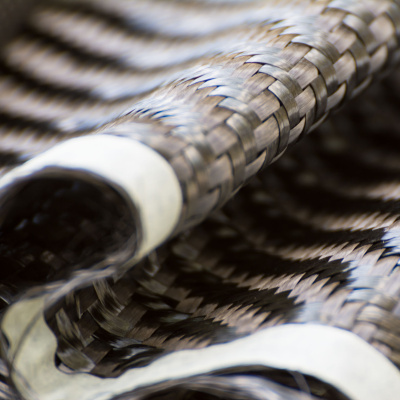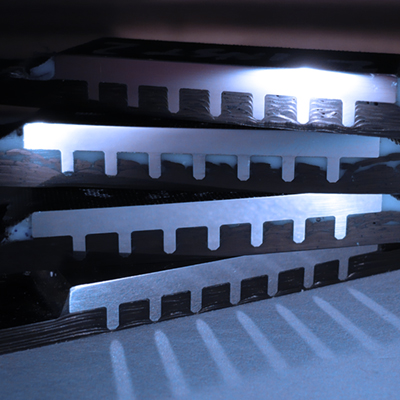Background
Carbon fibre sheet moulding compounds (CFSMC) have multiple advantages for cost reduction in manufacturing articles out of composites, compared to traditionally used non-crimp fabric (NCF) lay-ups. Parts do not need preforming, no resin impregnation step is required and handling and forming can be automated, with curing in under three minutes at constant temperature according to recent developments. Extremely complex shapes can be moulded with a 'Class A' surface finish. However, SMCs have lower mechanical performance than continuous fibre systems. Also they can exhibit considerable variability in their mechanical behaviour [1,2], so use in automotive applications has tended to be restricted to non-structural parts.
One way to improve mechanical performance is to align the short fibres, using the resin flow during compression [3,4]. An alternative approach enabled by the current technology is to improve performance and predictability through embedding additional uni-directional (UD) fibre reinforcement during moulding, just where it is needed at selective locations in an SMC structure.
Above: Automotive boot lid - showing uni-directional carbon tape and steel fastener embedded in chopped carbon fibre moulding compound. Please note, image is purely illustrative.
Technology overview
Researchers at Cranfield University have developed new capabilities for low-cost, high manufacturing rate, lightweight structural parts. This is based on know-how in design and structural optimisation. The composition, position and orientation of UD tape is determined to achieve the desired properties and to minimise part thickness. Weight, cost effectiveness and stiffness are maximised according to loading, and metallic inserts can be robustly embedded for subsequent attachment of parts.
The design know-how is supplemented by a new manufacturing technique, illustrated in Figure 1 below, which overcomes one of the main limitations with the embedding of UD pre-preg tapes into SMC structures, namely the misalignment of UD fibres due to the extremely high moulding pressures needed for SMC flow. The manufacturing process allows for partial pre-curing of the UD tape (B-staging) to avoid this problem. An elastomeric carrier tool is used to place UD tape in the mould cavity with consistent pressure applied to the tape against the mould surface. The tapes become adhered to the tool faces so as to allow them to remain in desired positions on the surfaces of the moulds. The SMC charge is added and co-cured with rigidised UD prepreg. Cross linking occurs between the two resin layers in each material and allows net shape co-curing of the final hybrid part. Misalignment is avoided as the UD tapes are not displaced by the SMC material flow. The use of an elastomeric intensifier ensures consistent UD location and orientation.
Above: Figure 1 - Manufacturing technique using an elastomeric intensifier to place and B-stage UD (a,b,c) until adhesion to the mould. SMC is then added and co-cured with the UD (d,e,f).
Benefits
- Low variability of both strength and stiffness compared to high variability of standard CFSMC, providing high performance data values for part design;
- Potential weight savings of 30% compared to current CFSMC parts and >50% compared to current magnesium or aluminium parts;
- Weight saving provides manufacturing cost saving potential of up to 25% for high rate manufacturing;
- Sub 3 minute mould cycle time for low thickness parts;
- No compromise in part complexity or surface finish compared to current CFSMC designs;
- No increase in tooling investment compared to current SMC manufacturing;
- Wider applicability of designs with CFSMC manufacturing including highly loaded parts;
- Patented process facilitates supply chain and OEM discussions.
Applications
The design approach and manufacturing technique can be used for:
- Light weight structural components for improved performance and emissions of electric and other road vehicles, such as vehicle platforms, roof bars, roof panels, B-pillars, bulkheads, bonnet inners, boot floors;
- Light weight, high performance components for automotive, motorcycles and motor sport, such as sub-frames, suspension arms and strut attachments;
- High performance aerospace components substituting metal parts or reducing the weight, cost and manufacturing rate of composite parts;
- Sports utility components, such as electric scooters and blade bases;
- Industrial machinery requiring high stiffness, lightweight components, such as robots and other materials handling equipment.
Opportunity
Cranfield University is seeking expressions of interest from industrial partners wishing to utilise the design know-how and manufacturing processes to realise new products.
Licensees and potential users of the technology are invited to get in touch.
Patents
A UK patent application has been published (GB2566752A) with PCT application pending (WO2019/063980A1).
IP status
Patent applications submitted.
Seeking
Licensing, collaborative development, consultancy.
Figures
Above: Generic structure test element with 4-point bending property results.
Above: Stiffness comparison between simulation and experimental values. Experimental range bars are displayed.
References
- Qian C, Harper LT, Turner T a., Warrior N a. Notched behaviour of discontinuous carbon fibre composites: Comparison with quasi-isotropic non-crimp fabric. Compos Part A Appl Sci Manuf 2011; 42:293–302. doi:10.1016/j.compositesa.2010.12.001.
- Johanson K, Harper LT, Johnson MS, Warrior N a. Heterogeneity of discontinuous carbon fibre composites: Damage initiation captured by Digital Image Correlation.
- Harper LT, Turner T a., Martin JRB, Warrior N a. Fiber Alignment in Directed Carbon Fiber Preforms - Mechanical Property Prediction. J Compos Mater 2010; 44:931–51. doi:10.1177/0021998309347769.
- Yu H, Potter KD, Wisnom MR. A novel manufacturing method for aligned discontinuous fibre composites (High Performance-Discontinuous Fibre method). Compos Part A Appl Sci Manuf 2014; 65:175–85. doi:10.1016/j.compositesa.2014.06.005.
Above: Automotive boot floor and automotive suspension arm.
Above: Automotive bonnet inner stiffener panel and motorcycle frame brackets.








